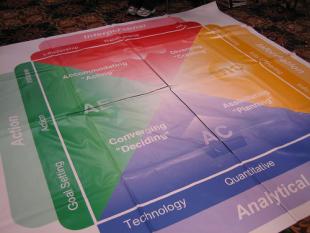I’ve recently been reading quite a few articles, tweets and blog posts about whether learning styles exist. Most I read make their arguments against, but there are still others who are holding onto their belief in the various models and theories. Both sides are blogging, tweeting and retweeting in defense of their positions.
Frankly, I don’t understand what all of the fuss is about. If believing in the presence of diverse learning styles makes you a better designer and learning facilitator–great! What really matters isn’t how you get there, but if you get there.
What is a “learning style”? The more popular among the models is Fleming’s VAK, which is based on Neuro-linguistic Programming (NLP). V = Visual, A = Auditory, and K = Kinesthetic. But Kolb’s Experiential Learning and Gardner’s Multiple Intelligences enter into the conversation as well (listing of theorists and their theories). These theorists all hold a place in the evolution and shaping of this work we call Workplace Learning and Performance* (that’s T&D for the rest of you).
Our roles in workplace learning and performance come with the responsibility–no, the obligation– to design, develop, facilitate and offer learning in ways that people learn best. And do the best we can to remove obstacles to them learning. That’s it.
How to accomplish this well isn’t difficult but it does take intention. So, in the spirit of the “3 R’s” (Readin’, ‘Ritin, & ‘Rithmatic) I offer the following quick litmus test items:
Relevant and Timely: Will the learners be able to apply what they’re leaning back on the job? Immediately? Do they need to have this knowledge right now in order to be successful? Based on the information provided, are the learners able to determine this for themselves?
I don’t know about you but I learn how to do things all of the time. However, if I don’t apply that learning very quickly, it goes away. No doubt filed in that mystical, secured storage area of my brain for which I have lost the password. For example, several years ago, I learned how to create models in MS Access used to mine lots of pages of financial data to summarize and report on trends. I haven’t had to use that set of skills and knowledge in quite some time. If I needed to be able to do this again tomorrow I would be freaking out and finding the ALL of the online tutorials for remedial education I could get my hands on. This is true because it is no longer stored anywhere in my brain that I can easily access.
Repetition: Are the key learning points repeated? If you want them to know them, gotta do it. For a variety of different reasons, Repetition has long been the way to ensure learners walk away with key learning points. Whether high tech or low, it is still a valid way for learners to learn.
When I was a child (111 years ago), my family had decks of flash cards for learning addition, subtraction, multiplication and fractions. (I hated those most) More recently, my nephew entered Navy Seals boot camp. His mom built an index card deck used to quiz him on the Navy “language” he needed to know to be successful in his first 6 week program. (Important success factors like the various ranks and what the chest ribbons mean!) While we have the ability to recreate this and mnemonic devices digitally these days, sometimes simple is still best. Either way, what’s important is that Repetition has always had a place in learning and it always will.
Reinforcement: Is the learning going to be Reinforced back on the job? In what ways? As learning professionals, we can’t afford to pass this responsibility off on the learners or their leaders. What type of tools and resources are available to the learner later so he/she can go back and access what they need at exactly the moment they need it. We owe it to the learners to have ways of referring back to the content and instruction. Otherwise, why are they going through the exercise?
Think performance. Think support. Think performance support. What additional learning exists and how do the learners get to it? Provide internal and external resources easily accessed on the organization’s intranet or provided in print. There are many ways of doing this—be creative!
In closing, I leave you with a quote from a very long time ago that is credited to Confucius. Note: he points out the need for variety and repetition too!
I hear and I forget. I see and I remember. I do and I understand.
Reading & Resources:
- “Design for Adult Learning, Teaching and Learning Theory, Feedback“, Michigan State University
- “The VARK Questionnaire: How Do I Learn Best?“, VARK Learn
- “Kolb’s Learning Styles and Experiential Learning Model“, Big Dog & Little Dog’s Performance Juxtaposition
- “What are multiple intelligences?“, Howard Gardner
Recent blog posts:
- “#LearningStyles ‘Awareness’ Day: Collected Resources“, David Kelly
- “#LearningStyles Awareness Day – Catering to Interaction Preferences Instead“, Judy Unrein
- “Brain Research and Learning Styles“, BrainX Blog
- “Learning Styles: It’s a Bit More Complicated than That“, Owen Ferguson
*Workplace Learning & Performance (WLP) is a contemporary definition crafted to encompass the various aspects and practices that are a part of the field. Specifically but not limited to, learning, performance, training, instructional design, development, human resources, organizational development, manufacturing, healthcare, (insert your favorite here).
Dawn Mahoney is the Manager of Divisional Learning & Development at Brookdale Senior Living. Find her on Twitter (@dawnjmahoney) or on LinkedIn.
Image credit: Wandering Eyre on Flickr






